Auditing and Compliance Report: Financial Analysis of DIPL Ltd
VerifiedAdded on 2020/03/07
|11
|2816
|20
Report
AI Summary
This report provides an in-depth analysis of auditing procedures, financial ratios, and risk assessment for DIPL Ltd. It examines substantive procedures, trend and ratio analysis to evaluate the company's financial performance over a three-year period, highlighting liquidity, profitability, and asset turnover. The report identifies inherent risks related to cash receipts, bad debts, inventory, and accounts receivables, emphasizing the impact of ineffective internal controls and a new IT system. Furthermore, it explores fraud risks stemming from accounting system flaws and improper internal mechanisms, discussing the auditor's role in mitigating these risks. The report emphasizes the importance of effective bank reconciliation, management scrutiny, and the auditor's understanding of the IT system to ensure accurate financial reporting and informed decision-making. The report also stresses the impact of management's involvement in fraudulent activities and its effect on the auditor's decision.
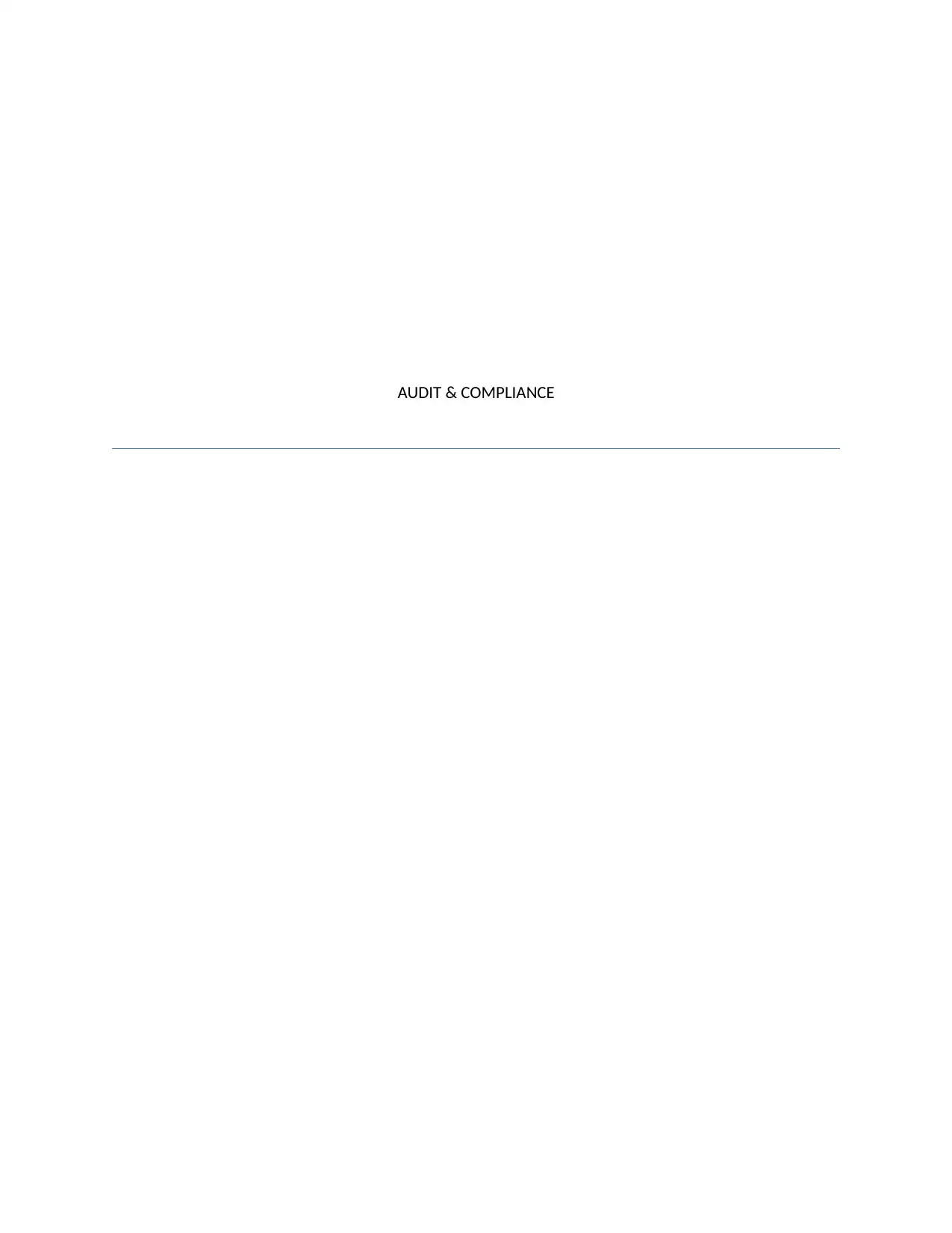
AUDIT & COMPLIANCE
Paraphrase This Document
Need a fresh take? Get an instant paraphrase of this document with our AI Paraphraser
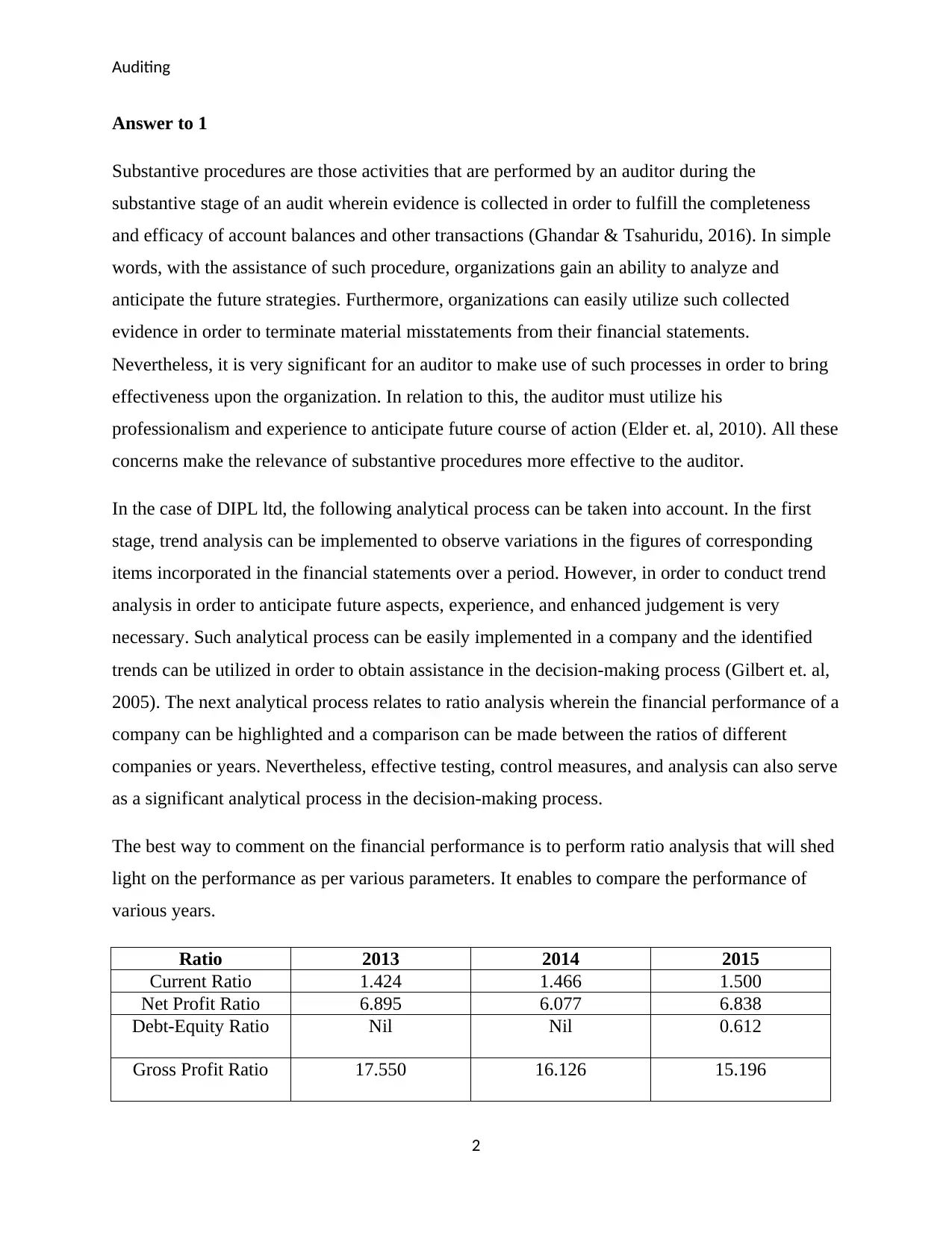
Auditing
Answer to 1
Substantive procedures are those activities that are performed by an auditor during the
substantive stage of an audit wherein evidence is collected in order to fulfill the completeness
and efficacy of account balances and other transactions (Ghandar & Tsahuridu, 2016). In simple
words, with the assistance of such procedure, organizations gain an ability to analyze and
anticipate the future strategies. Furthermore, organizations can easily utilize such collected
evidence in order to terminate material misstatements from their financial statements.
Nevertheless, it is very significant for an auditor to make use of such processes in order to bring
effectiveness upon the organization. In relation to this, the auditor must utilize his
professionalism and experience to anticipate future course of action (Elder et. al, 2010). All these
concerns make the relevance of substantive procedures more effective to the auditor.
In the case of DIPL ltd, the following analytical process can be taken into account. In the first
stage, trend analysis can be implemented to observe variations in the figures of corresponding
items incorporated in the financial statements over a period. However, in order to conduct trend
analysis in order to anticipate future aspects, experience, and enhanced judgement is very
necessary. Such analytical process can be easily implemented in a company and the identified
trends can be utilized in order to obtain assistance in the decision-making process (Gilbert et. al,
2005). The next analytical process relates to ratio analysis wherein the financial performance of a
company can be highlighted and a comparison can be made between the ratios of different
companies or years. Nevertheless, effective testing, control measures, and analysis can also serve
as a significant analytical process in the decision-making process.
The best way to comment on the financial performance is to perform ratio analysis that will shed
light on the performance as per various parameters. It enables to compare the performance of
various years.
Ratio 2013 2014 2015
Current Ratio 1.424 1.466 1.500
Net Profit Ratio 6.895 6.077 6.838
Debt-Equity Ratio Nil Nil 0.612
Gross Profit Ratio 17.550 16.126 15.196
2
Answer to 1
Substantive procedures are those activities that are performed by an auditor during the
substantive stage of an audit wherein evidence is collected in order to fulfill the completeness
and efficacy of account balances and other transactions (Ghandar & Tsahuridu, 2016). In simple
words, with the assistance of such procedure, organizations gain an ability to analyze and
anticipate the future strategies. Furthermore, organizations can easily utilize such collected
evidence in order to terminate material misstatements from their financial statements.
Nevertheless, it is very significant for an auditor to make use of such processes in order to bring
effectiveness upon the organization. In relation to this, the auditor must utilize his
professionalism and experience to anticipate future course of action (Elder et. al, 2010). All these
concerns make the relevance of substantive procedures more effective to the auditor.
In the case of DIPL ltd, the following analytical process can be taken into account. In the first
stage, trend analysis can be implemented to observe variations in the figures of corresponding
items incorporated in the financial statements over a period. However, in order to conduct trend
analysis in order to anticipate future aspects, experience, and enhanced judgement is very
necessary. Such analytical process can be easily implemented in a company and the identified
trends can be utilized in order to obtain assistance in the decision-making process (Gilbert et. al,
2005). The next analytical process relates to ratio analysis wherein the financial performance of a
company can be highlighted and a comparison can be made between the ratios of different
companies or years. Nevertheless, effective testing, control measures, and analysis can also serve
as a significant analytical process in the decision-making process.
The best way to comment on the financial performance is to perform ratio analysis that will shed
light on the performance as per various parameters. It enables to compare the performance of
various years.
Ratio 2013 2014 2015
Current Ratio 1.424 1.466 1.500
Net Profit Ratio 6.895 6.077 6.838
Debt-Equity Ratio Nil Nil 0.612
Gross Profit Ratio 17.550 16.126 15.196
2
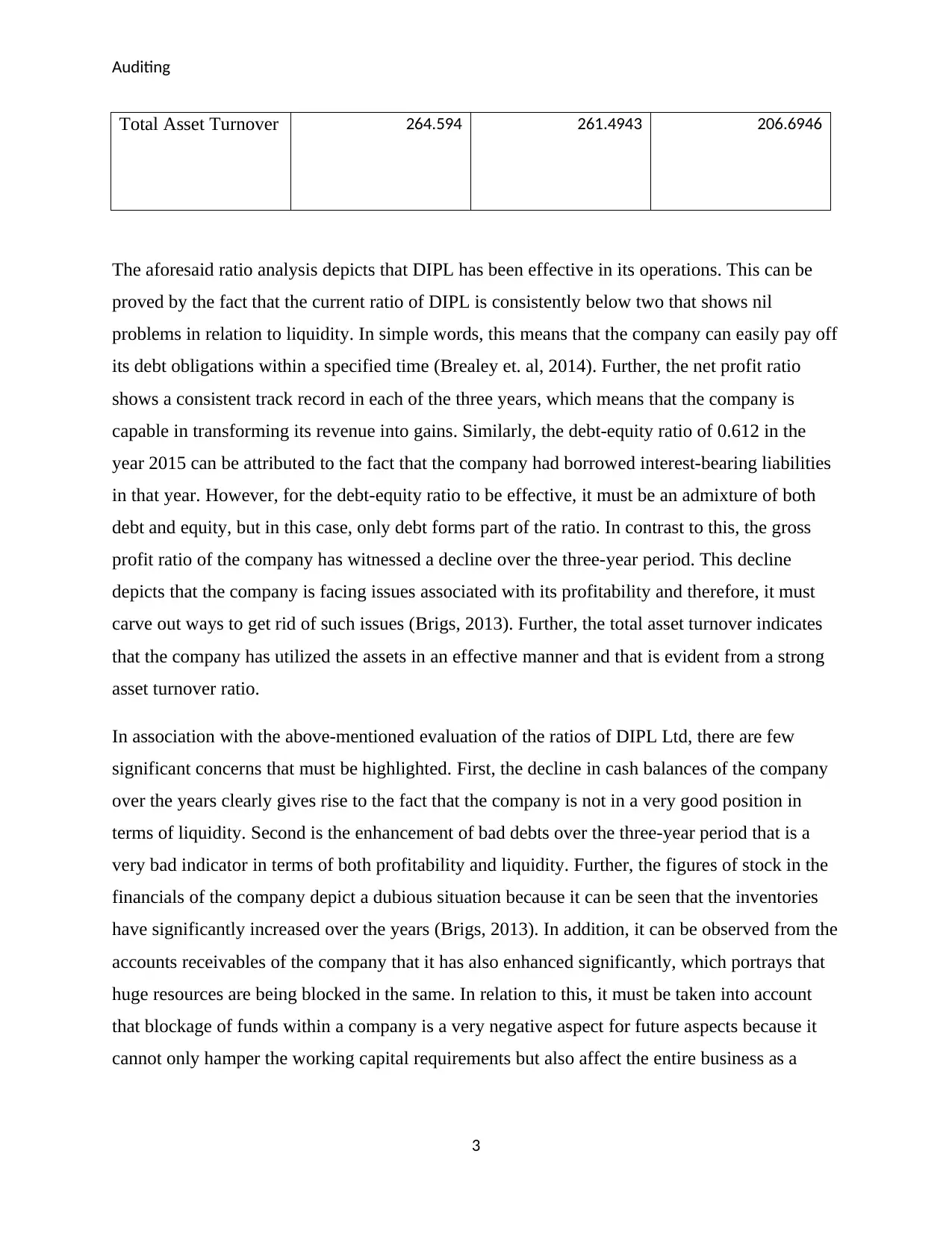
Auditing
Total Asset Turnover 264.594 261.4943 206.6946
The aforesaid ratio analysis depicts that DIPL has been effective in its operations. This can be
proved by the fact that the current ratio of DIPL is consistently below two that shows nil
problems in relation to liquidity. In simple words, this means that the company can easily pay off
its debt obligations within a specified time (Brealey et. al, 2014). Further, the net profit ratio
shows a consistent track record in each of the three years, which means that the company is
capable in transforming its revenue into gains. Similarly, the debt-equity ratio of 0.612 in the
year 2015 can be attributed to the fact that the company had borrowed interest-bearing liabilities
in that year. However, for the debt-equity ratio to be effective, it must be an admixture of both
debt and equity, but in this case, only debt forms part of the ratio. In contrast to this, the gross
profit ratio of the company has witnessed a decline over the three-year period. This decline
depicts that the company is facing issues associated with its profitability and therefore, it must
carve out ways to get rid of such issues (Brigs, 2013). Further, the total asset turnover indicates
that the company has utilized the assets in an effective manner and that is evident from a strong
asset turnover ratio.
In association with the above-mentioned evaluation of the ratios of DIPL Ltd, there are few
significant concerns that must be highlighted. First, the decline in cash balances of the company
over the years clearly gives rise to the fact that the company is not in a very good position in
terms of liquidity. Second is the enhancement of bad debts over the three-year period that is a
very bad indicator in terms of both profitability and liquidity. Further, the figures of stock in the
financials of the company depict a dubious situation because it can be seen that the inventories
have significantly increased over the years (Brigs, 2013). In addition, it can be observed from the
accounts receivables of the company that it has also enhanced significantly, which portrays that
huge resources are being blocked in the same. In relation to this, it must be taken into account
that blockage of funds within a company is a very negative aspect for future aspects because it
cannot only hamper the working capital requirements but also affect the entire business as a
3
Total Asset Turnover 264.594 261.4943 206.6946
The aforesaid ratio analysis depicts that DIPL has been effective in its operations. This can be
proved by the fact that the current ratio of DIPL is consistently below two that shows nil
problems in relation to liquidity. In simple words, this means that the company can easily pay off
its debt obligations within a specified time (Brealey et. al, 2014). Further, the net profit ratio
shows a consistent track record in each of the three years, which means that the company is
capable in transforming its revenue into gains. Similarly, the debt-equity ratio of 0.612 in the
year 2015 can be attributed to the fact that the company had borrowed interest-bearing liabilities
in that year. However, for the debt-equity ratio to be effective, it must be an admixture of both
debt and equity, but in this case, only debt forms part of the ratio. In contrast to this, the gross
profit ratio of the company has witnessed a decline over the three-year period. This decline
depicts that the company is facing issues associated with its profitability and therefore, it must
carve out ways to get rid of such issues (Brigs, 2013). Further, the total asset turnover indicates
that the company has utilized the assets in an effective manner and that is evident from a strong
asset turnover ratio.
In association with the above-mentioned evaluation of the ratios of DIPL Ltd, there are few
significant concerns that must be highlighted. First, the decline in cash balances of the company
over the years clearly gives rise to the fact that the company is not in a very good position in
terms of liquidity. Second is the enhancement of bad debts over the three-year period that is a
very bad indicator in terms of both profitability and liquidity. Further, the figures of stock in the
financials of the company depict a dubious situation because it can be seen that the inventories
have significantly increased over the years (Brigs, 2013). In addition, it can be observed from the
accounts receivables of the company that it has also enhanced significantly, which portrays that
huge resources are being blocked in the same. In relation to this, it must be taken into account
that blockage of funds within a company is a very negative aspect for future aspects because it
cannot only hamper the working capital requirements but also affect the entire business as a
3
⊘ This is a preview!⊘
Do you want full access?
Subscribe today to unlock all pages.

Trusted by 1+ million students worldwide
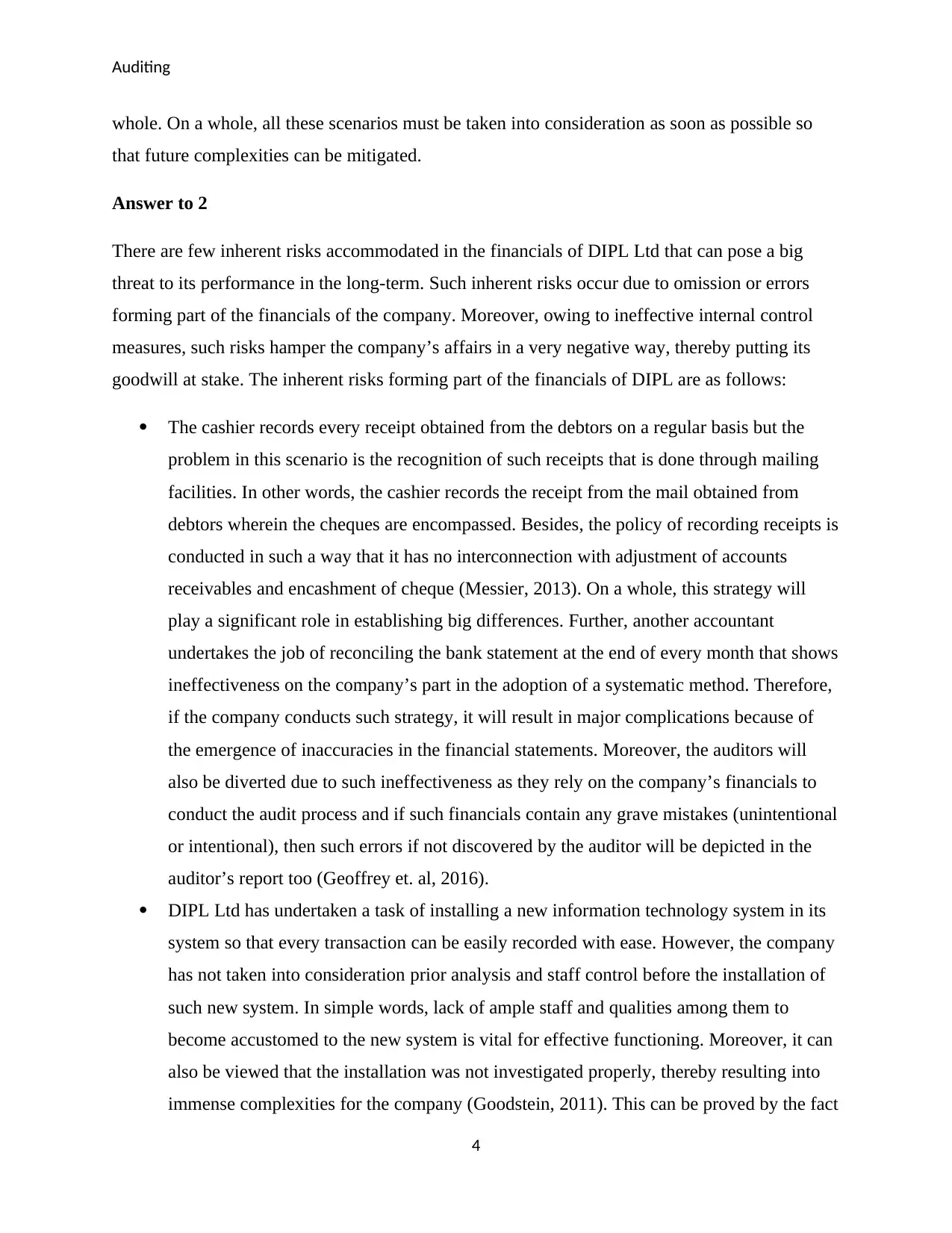
Auditing
whole. On a whole, all these scenarios must be taken into consideration as soon as possible so
that future complexities can be mitigated.
Answer to 2
There are few inherent risks accommodated in the financials of DIPL Ltd that can pose a big
threat to its performance in the long-term. Such inherent risks occur due to omission or errors
forming part of the financials of the company. Moreover, owing to ineffective internal control
measures, such risks hamper the company’s affairs in a very negative way, thereby putting its
goodwill at stake. The inherent risks forming part of the financials of DIPL are as follows:
The cashier records every receipt obtained from the debtors on a regular basis but the
problem in this scenario is the recognition of such receipts that is done through mailing
facilities. In other words, the cashier records the receipt from the mail obtained from
debtors wherein the cheques are encompassed. Besides, the policy of recording receipts is
conducted in such a way that it has no interconnection with adjustment of accounts
receivables and encashment of cheque (Messier, 2013). On a whole, this strategy will
play a significant role in establishing big differences. Further, another accountant
undertakes the job of reconciling the bank statement at the end of every month that shows
ineffectiveness on the company’s part in the adoption of a systematic method. Therefore,
if the company conducts such strategy, it will result in major complications because of
the emergence of inaccuracies in the financial statements. Moreover, the auditors will
also be diverted due to such ineffectiveness as they rely on the company’s financials to
conduct the audit process and if such financials contain any grave mistakes (unintentional
or intentional), then such errors if not discovered by the auditor will be depicted in the
auditor’s report too (Geoffrey et. al, 2016).
DIPL Ltd has undertaken a task of installing a new information technology system in its
system so that every transaction can be easily recorded with ease. However, the company
has not taken into consideration prior analysis and staff control before the installation of
such new system. In simple words, lack of ample staff and qualities among them to
become accustomed to the new system is vital for effective functioning. Moreover, it can
also be viewed that the installation was not investigated properly, thereby resulting into
immense complexities for the company (Goodstein, 2011). This can be proved by the fact
4
whole. On a whole, all these scenarios must be taken into consideration as soon as possible so
that future complexities can be mitigated.
Answer to 2
There are few inherent risks accommodated in the financials of DIPL Ltd that can pose a big
threat to its performance in the long-term. Such inherent risks occur due to omission or errors
forming part of the financials of the company. Moreover, owing to ineffective internal control
measures, such risks hamper the company’s affairs in a very negative way, thereby putting its
goodwill at stake. The inherent risks forming part of the financials of DIPL are as follows:
The cashier records every receipt obtained from the debtors on a regular basis but the
problem in this scenario is the recognition of such receipts that is done through mailing
facilities. In other words, the cashier records the receipt from the mail obtained from
debtors wherein the cheques are encompassed. Besides, the policy of recording receipts is
conducted in such a way that it has no interconnection with adjustment of accounts
receivables and encashment of cheque (Messier, 2013). On a whole, this strategy will
play a significant role in establishing big differences. Further, another accountant
undertakes the job of reconciling the bank statement at the end of every month that shows
ineffectiveness on the company’s part in the adoption of a systematic method. Therefore,
if the company conducts such strategy, it will result in major complications because of
the emergence of inaccuracies in the financial statements. Moreover, the auditors will
also be diverted due to such ineffectiveness as they rely on the company’s financials to
conduct the audit process and if such financials contain any grave mistakes (unintentional
or intentional), then such errors if not discovered by the auditor will be depicted in the
auditor’s report too (Geoffrey et. al, 2016).
DIPL Ltd has undertaken a task of installing a new information technology system in its
system so that every transaction can be easily recorded with ease. However, the company
has not taken into consideration prior analysis and staff control before the installation of
such new system. In simple words, lack of ample staff and qualities among them to
become accustomed to the new system is vital for effective functioning. Moreover, it can
also be viewed that the installation was not investigated properly, thereby resulting into
immense complexities for the company (Goodstein, 2011). This can be proved by the fact
4
Paraphrase This Document
Need a fresh take? Get an instant paraphrase of this document with our AI Paraphraser
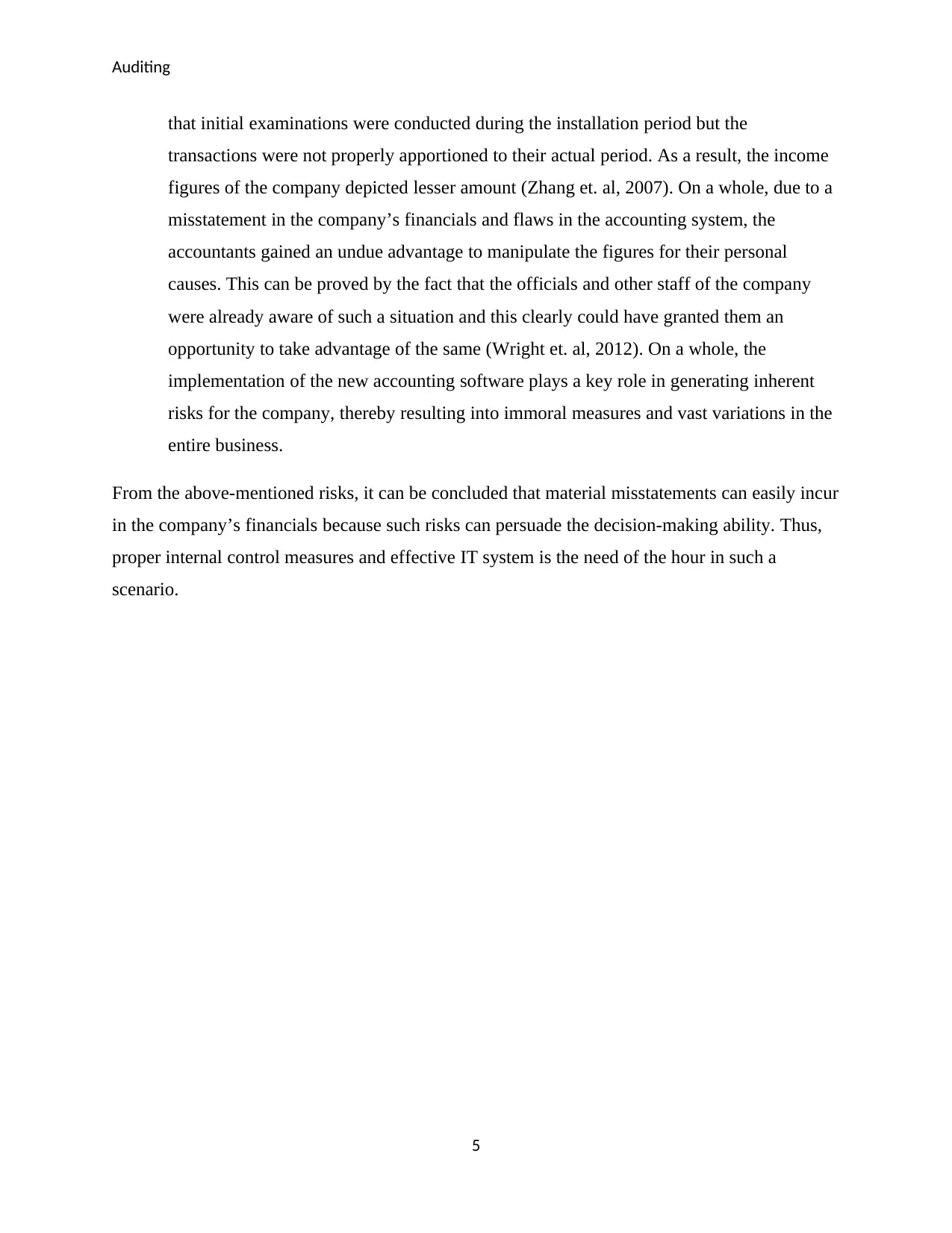
Auditing
that initial examinations were conducted during the installation period but the
transactions were not properly apportioned to their actual period. As a result, the income
figures of the company depicted lesser amount (Zhang et. al, 2007). On a whole, due to a
misstatement in the company’s financials and flaws in the accounting system, the
accountants gained an undue advantage to manipulate the figures for their personal
causes. This can be proved by the fact that the officials and other staff of the company
were already aware of such a situation and this clearly could have granted them an
opportunity to take advantage of the same (Wright et. al, 2012). On a whole, the
implementation of the new accounting software plays a key role in generating inherent
risks for the company, thereby resulting into immoral measures and vast variations in the
entire business.
From the above-mentioned risks, it can be concluded that material misstatements can easily incur
in the company’s financials because such risks can persuade the decision-making ability. Thus,
proper internal control measures and effective IT system is the need of the hour in such a
scenario.
5
that initial examinations were conducted during the installation period but the
transactions were not properly apportioned to their actual period. As a result, the income
figures of the company depicted lesser amount (Zhang et. al, 2007). On a whole, due to a
misstatement in the company’s financials and flaws in the accounting system, the
accountants gained an undue advantage to manipulate the figures for their personal
causes. This can be proved by the fact that the officials and other staff of the company
were already aware of such a situation and this clearly could have granted them an
opportunity to take advantage of the same (Wright et. al, 2012). On a whole, the
implementation of the new accounting software plays a key role in generating inherent
risks for the company, thereby resulting into immoral measures and vast variations in the
entire business.
From the above-mentioned risks, it can be concluded that material misstatements can easily incur
in the company’s financials because such risks can persuade the decision-making ability. Thus,
proper internal control measures and effective IT system is the need of the hour in such a
scenario.
5

Auditing
Answer to 3(a)
There are two types of fraud risks owing to the business nature of DIPL Ltd:
Due to an improper examination of the new IT system, inaccurate details were
incorporated into the system, thereby resulting in inappropriate accounting figures in the
financial statements. Therefore, the biggest fraud risk in such a case is that of hampering
the account balances. Moreover, because of such improper measures, accountants can
easily gain an advantage to influence the account balances in a way that they never are
caught (Douglas et. al, 2015). For example, it may happen that the accountants write off
some outstanding amounts and settle them outside for self-interest benefits. On a whole,
the new IT system can result in a grave scenario because of inefficacies in recording the
data.
Since the company records its receipts through mailing facilities, it can encounter severe
complications because bank certification is missing in such scenario, thereby resulting in
fraudulent practices on the part of accountants. In relation to such a situation, it is very
significant that prior and effective verification is done with the bank with the help of a
bank statement so that the accountants can easily refer any amount that necessitates
authentication (Jubb, 2012). Further, it can also be observed that the company has been
conducting immoral internal control mechanisms within its affairs. As a result, it may
happen that such accountants transfer the resources of the company to a wrong person
and take advantage of the same funds for personal causes (Douglas et. al, 2015). Hence,
this cannot only affect the financial position of DIPL but also its resources as a whole. On
a whole, an effective bank reconciliation system has become the need of the hour in such
scenario. In addition, it is the responsibility of the management to carefully scrutinize
every detail forming part of the financial statements of the company on a regular basis so
that a stronger connection can be established, thereby ultimately resulting into enhanced
transparency.
Answer to 3(b)
The decision of auditor may fail to prove effective if the management is also indulged in
conducting such fraudulent steps. The key reason behind such ideology can be attributed to the
6
Answer to 3(a)
There are two types of fraud risks owing to the business nature of DIPL Ltd:
Due to an improper examination of the new IT system, inaccurate details were
incorporated into the system, thereby resulting in inappropriate accounting figures in the
financial statements. Therefore, the biggest fraud risk in such a case is that of hampering
the account balances. Moreover, because of such improper measures, accountants can
easily gain an advantage to influence the account balances in a way that they never are
caught (Douglas et. al, 2015). For example, it may happen that the accountants write off
some outstanding amounts and settle them outside for self-interest benefits. On a whole,
the new IT system can result in a grave scenario because of inefficacies in recording the
data.
Since the company records its receipts through mailing facilities, it can encounter severe
complications because bank certification is missing in such scenario, thereby resulting in
fraudulent practices on the part of accountants. In relation to such a situation, it is very
significant that prior and effective verification is done with the bank with the help of a
bank statement so that the accountants can easily refer any amount that necessitates
authentication (Jubb, 2012). Further, it can also be observed that the company has been
conducting immoral internal control mechanisms within its affairs. As a result, it may
happen that such accountants transfer the resources of the company to a wrong person
and take advantage of the same funds for personal causes (Douglas et. al, 2015). Hence,
this cannot only affect the financial position of DIPL but also its resources as a whole. On
a whole, an effective bank reconciliation system has become the need of the hour in such
scenario. In addition, it is the responsibility of the management to carefully scrutinize
every detail forming part of the financial statements of the company on a regular basis so
that a stronger connection can be established, thereby ultimately resulting into enhanced
transparency.
Answer to 3(b)
The decision of auditor may fail to prove effective if the management is also indulged in
conducting such fraudulent steps. The key reason behind such ideology can be attributed to the
6
⊘ This is a preview!⊘
Do you want full access?
Subscribe today to unlock all pages.

Trusted by 1+ million students worldwide
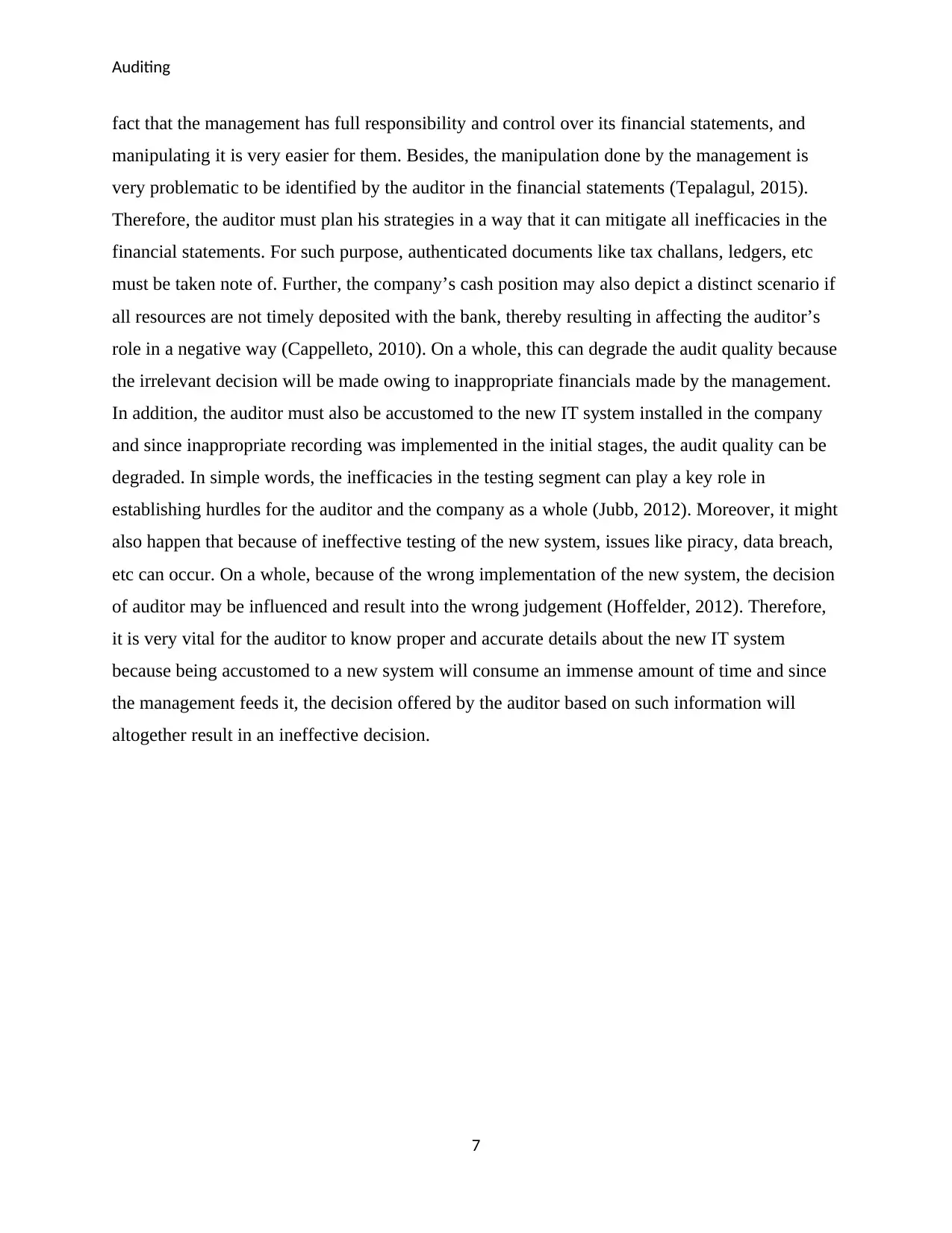
Auditing
fact that the management has full responsibility and control over its financial statements, and
manipulating it is very easier for them. Besides, the manipulation done by the management is
very problematic to be identified by the auditor in the financial statements (Tepalagul, 2015).
Therefore, the auditor must plan his strategies in a way that it can mitigate all inefficacies in the
financial statements. For such purpose, authenticated documents like tax challans, ledgers, etc
must be taken note of. Further, the company’s cash position may also depict a distinct scenario if
all resources are not timely deposited with the bank, thereby resulting in affecting the auditor’s
role in a negative way (Cappelleto, 2010). On a whole, this can degrade the audit quality because
the irrelevant decision will be made owing to inappropriate financials made by the management.
In addition, the auditor must also be accustomed to the new IT system installed in the company
and since inappropriate recording was implemented in the initial stages, the audit quality can be
degraded. In simple words, the inefficacies in the testing segment can play a key role in
establishing hurdles for the auditor and the company as a whole (Jubb, 2012). Moreover, it might
also happen that because of ineffective testing of the new system, issues like piracy, data breach,
etc can occur. On a whole, because of the wrong implementation of the new system, the decision
of auditor may be influenced and result into the wrong judgement (Hoffelder, 2012). Therefore,
it is very vital for the auditor to know proper and accurate details about the new IT system
because being accustomed to a new system will consume an immense amount of time and since
the management feeds it, the decision offered by the auditor based on such information will
altogether result in an ineffective decision.
7
fact that the management has full responsibility and control over its financial statements, and
manipulating it is very easier for them. Besides, the manipulation done by the management is
very problematic to be identified by the auditor in the financial statements (Tepalagul, 2015).
Therefore, the auditor must plan his strategies in a way that it can mitigate all inefficacies in the
financial statements. For such purpose, authenticated documents like tax challans, ledgers, etc
must be taken note of. Further, the company’s cash position may also depict a distinct scenario if
all resources are not timely deposited with the bank, thereby resulting in affecting the auditor’s
role in a negative way (Cappelleto, 2010). On a whole, this can degrade the audit quality because
the irrelevant decision will be made owing to inappropriate financials made by the management.
In addition, the auditor must also be accustomed to the new IT system installed in the company
and since inappropriate recording was implemented in the initial stages, the audit quality can be
degraded. In simple words, the inefficacies in the testing segment can play a key role in
establishing hurdles for the auditor and the company as a whole (Jubb, 2012). Moreover, it might
also happen that because of ineffective testing of the new system, issues like piracy, data breach,
etc can occur. On a whole, because of the wrong implementation of the new system, the decision
of auditor may be influenced and result into the wrong judgement (Hoffelder, 2012). Therefore,
it is very vital for the auditor to know proper and accurate details about the new IT system
because being accustomed to a new system will consume an immense amount of time and since
the management feeds it, the decision offered by the auditor based on such information will
altogether result in an ineffective decision.
7
Paraphrase This Document
Need a fresh take? Get an instant paraphrase of this document with our AI Paraphraser
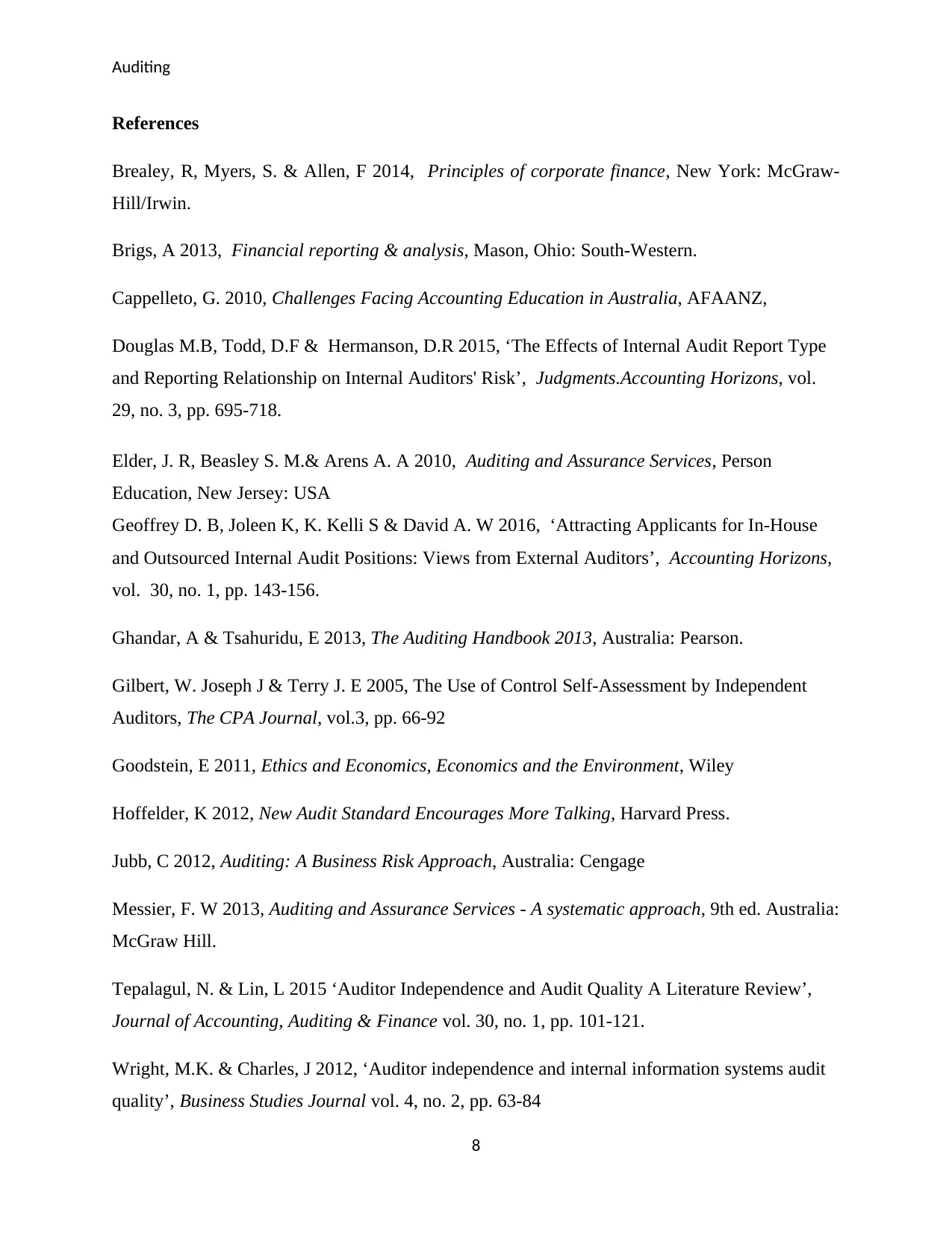
Auditing
References
Brealey, R, Myers, S. & Allen, F 2014, Principles of corporate finance, New York: McGraw-
Hill/Irwin.
Brigs, A 2013, Financial reporting & analysis, Mason, Ohio: South-Western.
Cappelleto, G. 2010, Challenges Facing Accounting Education in Australia, AFAANZ,
Douglas M.B, Todd, D.F & Hermanson, D.R 2015, ‘The Effects of Internal Audit Report Type
and Reporting Relationship on Internal Auditors' Risk’, Judgments.Accounting Horizons, vol.
29, no. 3, pp. 695-718.
Elder, J. R, Beasley S. M.& Arens A. A 2010, Auditing and Assurance Services, Person
Education, New Jersey: USA
Geoffrey D. B, Joleen K, K. Kelli S & David A. W 2016, ‘Attracting Applicants for In-House
and Outsourced Internal Audit Positions: Views from External Auditors’, Accounting Horizons,
vol. 30, no. 1, pp. 143-156.
Ghandar, A & Tsahuridu, E 2013, The Auditing Handbook 2013, Australia: Pearson.
Gilbert, W. Joseph J & Terry J. E 2005, The Use of Control Self-Assessment by Independent
Auditors, The CPA Journal, vol.3, pp. 66-92
Goodstein, E 2011, Ethics and Economics, Economics and the Environment, Wiley
Hoffelder, K 2012, New Audit Standard Encourages More Talking, Harvard Press.
Jubb, C 2012, Auditing: A Business Risk Approach, Australia: Cengage
Messier, F. W 2013, Auditing and Assurance Services - A systematic approach, 9th ed. Australia:
McGraw Hill.
Tepalagul, N. & Lin, L 2015 ‘Auditor Independence and Audit Quality A Literature Review’,
Journal of Accounting, Auditing & Finance vol. 30, no. 1, pp. 101-121.
Wright, M.K. & Charles, J 2012, ‘Auditor independence and internal information systems audit
quality’, Business Studies Journal vol. 4, no. 2, pp. 63-84
8
References
Brealey, R, Myers, S. & Allen, F 2014, Principles of corporate finance, New York: McGraw-
Hill/Irwin.
Brigs, A 2013, Financial reporting & analysis, Mason, Ohio: South-Western.
Cappelleto, G. 2010, Challenges Facing Accounting Education in Australia, AFAANZ,
Douglas M.B, Todd, D.F & Hermanson, D.R 2015, ‘The Effects of Internal Audit Report Type
and Reporting Relationship on Internal Auditors' Risk’, Judgments.Accounting Horizons, vol.
29, no. 3, pp. 695-718.
Elder, J. R, Beasley S. M.& Arens A. A 2010, Auditing and Assurance Services, Person
Education, New Jersey: USA
Geoffrey D. B, Joleen K, K. Kelli S & David A. W 2016, ‘Attracting Applicants for In-House
and Outsourced Internal Audit Positions: Views from External Auditors’, Accounting Horizons,
vol. 30, no. 1, pp. 143-156.
Ghandar, A & Tsahuridu, E 2013, The Auditing Handbook 2013, Australia: Pearson.
Gilbert, W. Joseph J & Terry J. E 2005, The Use of Control Self-Assessment by Independent
Auditors, The CPA Journal, vol.3, pp. 66-92
Goodstein, E 2011, Ethics and Economics, Economics and the Environment, Wiley
Hoffelder, K 2012, New Audit Standard Encourages More Talking, Harvard Press.
Jubb, C 2012, Auditing: A Business Risk Approach, Australia: Cengage
Messier, F. W 2013, Auditing and Assurance Services - A systematic approach, 9th ed. Australia:
McGraw Hill.
Tepalagul, N. & Lin, L 2015 ‘Auditor Independence and Audit Quality A Literature Review’,
Journal of Accounting, Auditing & Finance vol. 30, no. 1, pp. 101-121.
Wright, M.K. & Charles, J 2012, ‘Auditor independence and internal information systems audit
quality’, Business Studies Journal vol. 4, no. 2, pp. 63-84
8
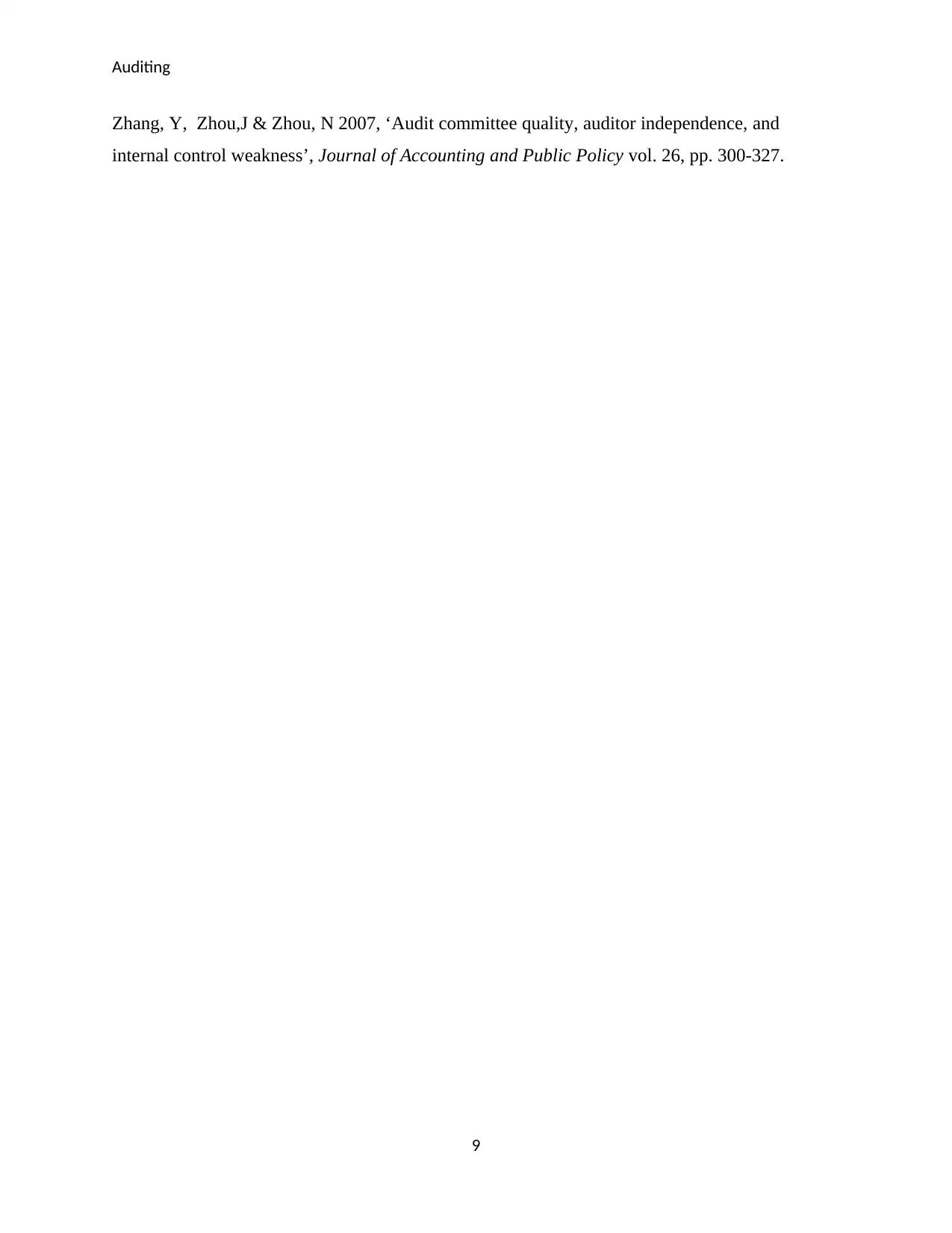
Auditing
Zhang, Y, Zhou,J & Zhou, N 2007, ‘Audit committee quality, auditor independence, and
internal control weakness’, Journal of Accounting and Public Policy vol. 26, pp. 300-327.
9
Zhang, Y, Zhou,J & Zhou, N 2007, ‘Audit committee quality, auditor independence, and
internal control weakness’, Journal of Accounting and Public Policy vol. 26, pp. 300-327.
9
⊘ This is a preview!⊘
Do you want full access?
Subscribe today to unlock all pages.

Trusted by 1+ million students worldwide
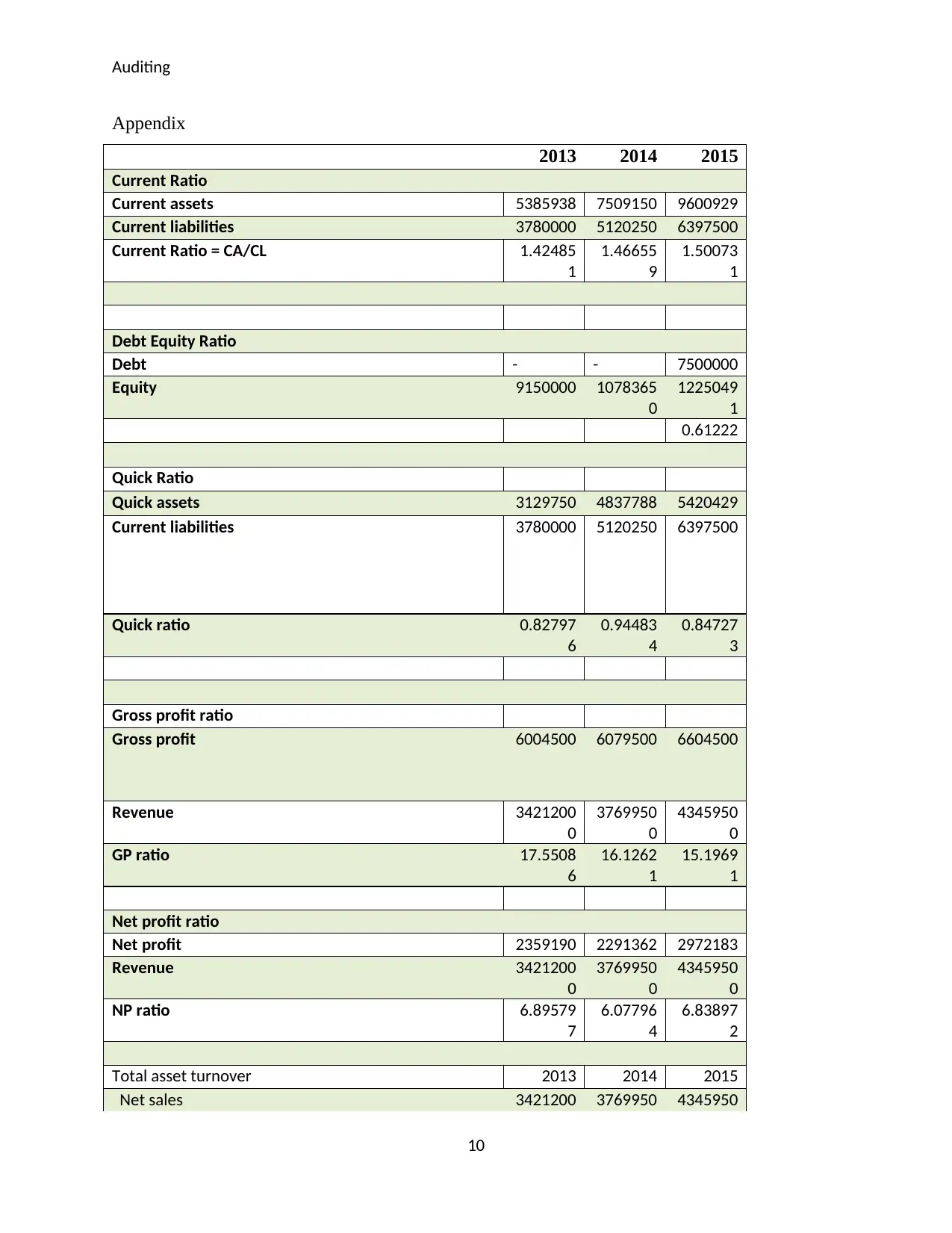
Auditing
Appendix
2013 2014 2015
Current Ratio
Current assets 5385938 7509150 9600929
Current liabilities 3780000 5120250 6397500
Current Ratio = CA/CL 1.42485
1
1.46655
9
1.50073
1
Debt Equity Ratio
Debt - - 7500000
Equity 9150000 1078365
0
1225049
1
0.61222
Quick Ratio
Quick assets 3129750 4837788 5420429
Current liabilities 3780000 5120250 6397500
Quick ratio 0.82797
6
0.94483
4
0.84727
3
Gross profit ratio
Gross profit 6004500 6079500 6604500
Revenue 3421200
0
3769950
0
4345950
0
GP ratio 17.5508
6
16.1262
1
15.1969
1
Net profit ratio
Net profit 2359190 2291362 2972183
Revenue 3421200
0
3769950
0
4345950
0
NP ratio 6.89579
7
6.07796
4
6.83897
2
Total asset turnover 2013 2014 2015
Net sales 3421200 3769950 4345950
10
Appendix
2013 2014 2015
Current Ratio
Current assets 5385938 7509150 9600929
Current liabilities 3780000 5120250 6397500
Current Ratio = CA/CL 1.42485
1
1.46655
9
1.50073
1
Debt Equity Ratio
Debt - - 7500000
Equity 9150000 1078365
0
1225049
1
0.61222
Quick Ratio
Quick assets 3129750 4837788 5420429
Current liabilities 3780000 5120250 6397500
Quick ratio 0.82797
6
0.94483
4
0.84727
3
Gross profit ratio
Gross profit 6004500 6079500 6604500
Revenue 3421200
0
3769950
0
4345950
0
GP ratio 17.5508
6
16.1262
1
15.1969
1
Net profit ratio
Net profit 2359190 2291362 2972183
Revenue 3421200
0
3769950
0
4345950
0
NP ratio 6.89579
7
6.07796
4
6.83897
2
Total asset turnover 2013 2014 2015
Net sales 3421200 3769950 4345950
10
Paraphrase This Document
Need a fresh take? Get an instant paraphrase of this document with our AI Paraphraser
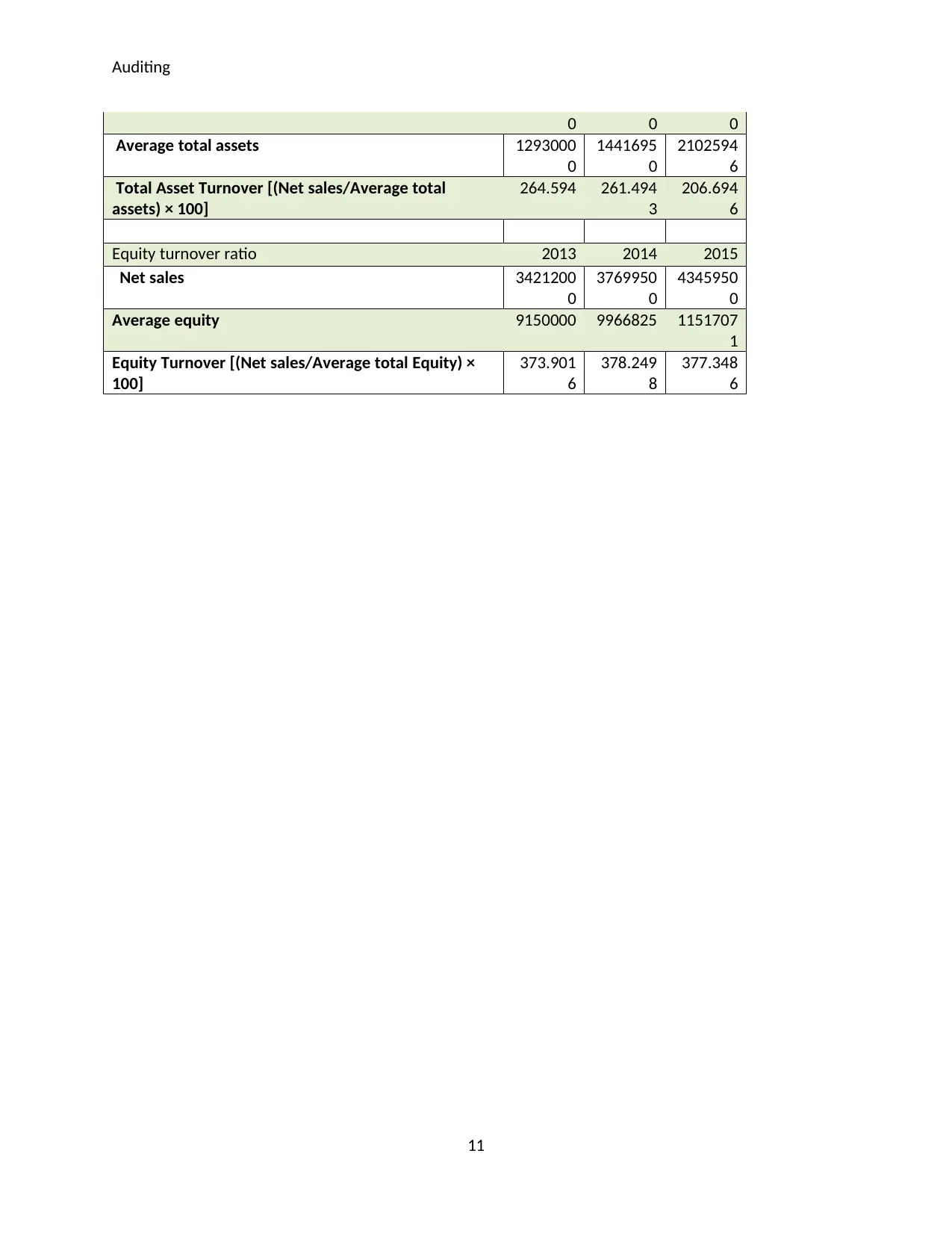
Auditing
0 0 0
Average total assets 1293000
0
1441695
0
2102594
6
Total Asset Turnover [(Net sales/Average total
assets) × 100]
264.594 261.494
3
206.694
6
Equity turnover ratio 2013 2014 2015
Net sales 3421200
0
3769950
0
4345950
0
Average equity 9150000 9966825 1151707
1
Equity Turnover [(Net sales/Average total Equity) ×
100]
373.901
6
378.249
8
377.348
6
11
0 0 0
Average total assets 1293000
0
1441695
0
2102594
6
Total Asset Turnover [(Net sales/Average total
assets) × 100]
264.594 261.494
3
206.694
6
Equity turnover ratio 2013 2014 2015
Net sales 3421200
0
3769950
0
4345950
0
Average equity 9150000 9966825 1151707
1
Equity Turnover [(Net sales/Average total Equity) ×
100]
373.901
6
378.249
8
377.348
6
11
1 out of 11
Related Documents
Your All-in-One AI-Powered Toolkit for Academic Success.
+13062052269
info@desklib.com
Available 24*7 on WhatsApp / Email
![[object Object]](/_next/static/media/star-bottom.7253800d.svg)
Unlock your academic potential
Copyright © 2020–2025 A2Z Services. All Rights Reserved. Developed and managed by ZUCOL.





